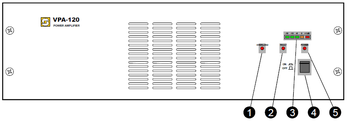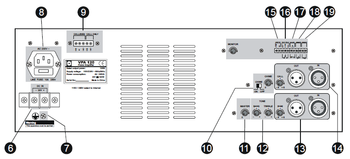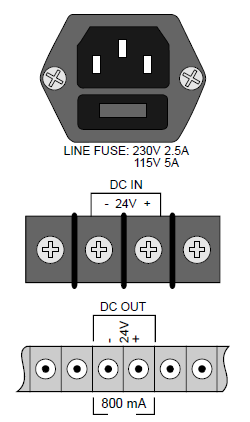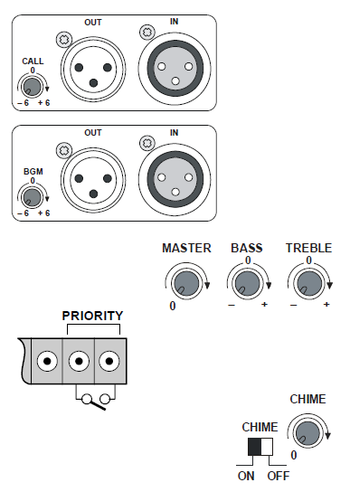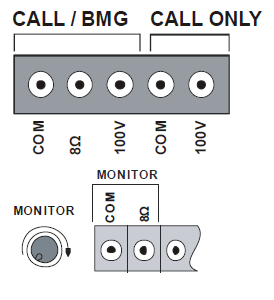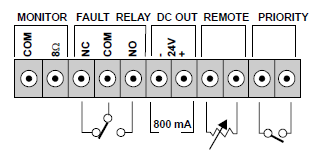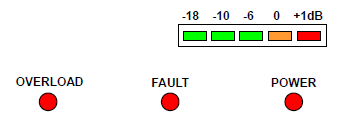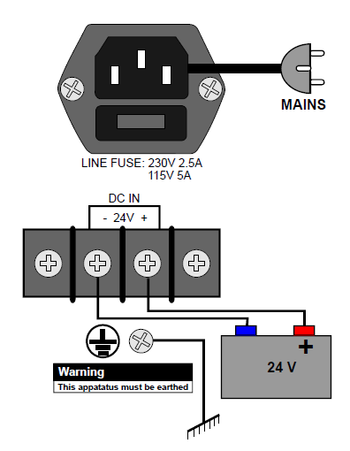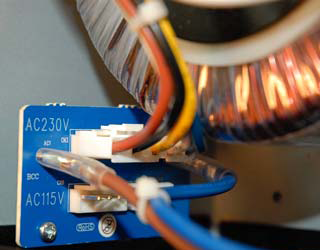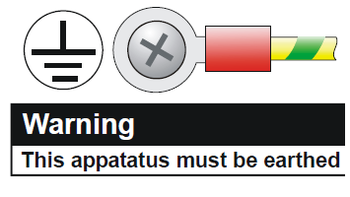VPA - Public Address Amplifiers
From Zenitel Wiki
INTRODUCTION
About this document
This manual is intended to give relevant information on the system
features, available equipment, typical configurations, simplified wiring
and programming and technical data for the concept.
This document is aimed at:
- Consultans
- Installers
- End users
Equipment covered by this document
Public adress amplifiers:
- VPA-120 (120 W)
- VPA-240 (240 W)
- VPA-400 (400 W (*1))
Note! The amplifiers are delivered for 230 VAC as standard. For 115 VAC mains, a plug must be removed and fuses must be changed. See section 3.3.4.
Rules and regulations
The VPA system and its components have been tested according to the following regulations:
- EN 60065: 2002
- “Audio, video and similar electronic apparatus. Safety requirements”
- IEC 60533: Second edition, 1999
- "Electrical and electronic installation in ships - Electromagnetic compatibility".
- EN 60945: Fourth edition, 2002
- "Maritime navigation and radio communication equipment and systems - General requirements - Methods of testing and required test results".
- IACS E10: Corr.1 July 2003
- "Unified environmental test specifications - Testing procedure for electric control and monitoring, safety and protection, onboard computer based systems and peripherals, loading instruments, internal communication and other electrical equipment as considered appropriate".
Publication log
v.1.0 - Sep. 2007
CONNECTORS AND CONTROLS
The connectors and controls of all three amplifier types are identical except for the maximum rated output power.
1 - Overload warning 2 - Fault warning 3 - VU-meter, -18, -10, -6, 0, +1dB 4 - Mains switch 5 - Power-on lamp 6 – 24 VDC backup power 7 – Frame ground connection 8 – Mains power connector and fuse 9 – Loudspeaker connections 10 – Pre-warning chime signal control 11 – Master volume control 12 – Master tone controls 13 – Entertainment input and output with volume preset 14 – Call/alarm audio input and output with volume preset 15 – 8 ohm monitor loudspeaker output with volume control 16 – no/nc relay for amplifier fault warning 17 – 24 VDC 800 mA power to external equipment 18 – Remote volume control 19 – Priority over entertainment input
Cabinet
The amplifier is prepared for mounting in a standard 19” rack and will occupy 3HU (133 mm) in height. The amplifier can also be free-standing on a level, open surface. Each amplifier has a built-in cooling fan, the front and back must be kept free of objects in order to secure sufficient air flow.
Power
The amplifiers are powered from 230 or 115 VAC mains, or 24 VDC.
The mains voltage is set inside the amplifier (default setting is 230 V). There is a mains circuit breaker on the cabinet front, and a mains fuse in conjunction with the mains inlet. The fuse value depends on the amplifier type.
24 VDC can be used as a backup source in case of mains power failure. The 24 V backup is not turned off by the mains switch or interrupted in
case of a blown mains fuse.
If an accumulator is used as 24 V backup, it will not be charged from the amplifier.
24 VDC/800 mA is available from the amplifier for external equipment.
The amplifier must be grounded either through the earth leg in the mains plug or by a 1.5 mm wire between the amplifier’s ground terminal and proven good grounding point, e.g. the rack frame.
Signal inputs
There are two inputs with 3-pin XLR connectors:
- Entertainment (BGM) for background music etc. with separate preset input level control.
- Call / alarm input for announcements and alarm messages with separate preset input level control.
Both inputs are connected in parallel with signal outputs to slave amplifiers or recorders.
There are common master tone- and volume controls for both inputs. In addition, the volume may be controlled remotely by an external potentiometer.
A call input signal will automatically mute the BGM entertainment source (VOX function). This can also be achieved manually by connecting the microphone switch to the priority terminals.
A pre-warning chime signal can be given in front of a message when a priority switch is pushed. This feature can be switched on/off and the chime loudness can be adjusted.
Loudspeaker outputs
There are three loudspeaker outputs:
- Call and Background Music (BMG), full power output available on an 8 Ohm terminal as well as on a 100 V constant voltage line.
- Call only, full power output on a 100 V constant voltage line. This terminal carries no background music.
- Monitor Loudspeaker, 1 W power output to an 8 Ohm loudspeaker, normally mounted close to the amplifier to monitor entertainment and call channels. The output has a separate volume control.
Optional connections
- Fault Relay, NO/NC contacts of a built-in relay is available for remote warning devices. The relay is activated during fault conditions such as mains power failure or open or shorted speaker lines.
- DC Out, 24 VDC/800 mA is available for optional equipment.
- Remote, connection of remote master volume control. A logaritmic 22 kOhm potmeter is suitable.
- Priority, by pushing a button on the microphone, a chime signal is manually activated in front of a message.
Indicators
- Power on, red LED is lit when the amplifier is powered from mains or battery.
- VU-meter, row of five LEDs indicating the signal pressure from -18 dB to +1 dB.
- Fault, a red warning LED will be lit if the master volume is set to less than 40%, or if the loudspeaker line is shorted. A fault relay will be activated during fault conditions; the switch-over contacts are available on the rear for remote warning devices.
- Overload, a red warning LED will be lit if the input signal is too high, or if the loudspeaker impedance is too low (too many loudspeakers in parallel) or shorted loudspeaker line.
INSTALLATION
Unpacking
The amplifier was thoroughly checked at the factory. Inspect the amplifier, the enclosed parts and the shipping container for signs of improper handling during shipment. If you find any damage, immediately contact the dealer from whom you purchased the unit to make a claim.
Mounting
The amplifier should be installed in a technical room with adequate ventilation, a recommended temperature between 18-25OC, less than 95% RH and an AC power outlet with provision for grounding.
The VPA rack is compass safe at a distance of >325 cm and the VPA panel needs 95 cm to be compass safe.
The amplifier is prepared for mounting in a rack with a standard width of 483 mm (19”), and 133 mm (3 HU - 5 ¼”) vertical space.
The rack must provide sufficient ventilation. A 1 HU ventilation grid above the amplifier is recommended if more than one amplifier are
mounted.
When VPA units are delivered ready mounted in a 19” rack like SPA and VPA systems, the 1HU grid is included.
WARNING:
Failure to observe the above precautions could result in overheating that could damage the equipment or create a fire hazard.
See also the data sheet for each amplifier.
Wiring
Cable requirement, marine installataions
All electrical wiring external to the equipment shall be approved shipcable of type 0.75 mm2 twisted pair with outer braided copper screen.
The cable should at least be a flame-retardant type to cover the requirement in SOLAS Ch. II-1/45.5.2.
Where cables for service are required to be operable under fire conditions, they must be a fire resistant type complying with the requirements of IEC 60331. That is where the cables pass through machinery spaces of category A and other high fire risk areas other than those which they serve.
For passenger vessels this requirement also applies for cables passing through main vertical fire zones (IACS UR E15).
- Examples of high fire risk areas are, apart from machinery space of category A:
- - Galleys and pantries containing cooking appliances
- - Laundry with drying equipment
- - Spaces defined by §§ (8), (12) and (14) of SOLAS Ch.II-2 Reg. 9.2.2.3.2.
- - Areas with fuel handling equipment
- The following electrical services are required to be operable under fire conditions:
- - Fire and general alarm system
- - Public address system
Cable layout
- Do not run the installation cable from microphone and alarm panels parallel to, or to near the cables for loudspeakers or power cables.
- The screens must be interconnected in junction boxes and grounded in the VPA main unit only. It is good practice to have separate conducts for each type of signal cabling.
- Two-conductor shielded cable is required for the microphone.
Mains power
WARNING: Do not connect AC power to the amplifier until all the necessary input and output connections have been completed. The customer must provide a dedicated single phase power input which should adhere to the following recommendations:
- 230 VAC, 50-60 Hz, fused and capable of delivering a maximum of 2 A per 100 Watt amplifier power.
- 24 VDC emergency power (if required), fused and capable of delivering a maximum of 8 A per 100 Watt amplifier power.
- The operating power should be wired and fused independently from all other inputs.
- The power must not be controlled by a mains switch.
- A warning tag should be attached to circuit-breaker-type fuses to prevent unauthorized manual operation.
- The mains power cable must be 3 x 2.5 mm2 rated for 500 VAC.
- The 24 VDC power cable dimension has to be calculated depending on the total low voltage power consumption and cable length.
- Proper grounding is essential for reliable operation.
Note! The VPA unit has to be connected to the vessel’s central
ground.
115 VAC mains
- Be sure the amplifier is set for the correct mains voltage. Default setting is 230 VAC.
- If there is 115 VAC in the mains outlet, a plug must be moved inside the cabinet.
- - Open the cabinet by removing the screws on both sides and remove the top cover.
- - Locate the power board close to the mains transformer and move the plug on CN3 (230V) to CN6 (115V).
- Change the fuse values according to the table in section 5.3.
Grounding
WARNING:
Do not disconnect the third (yellow/green) wire in the power plug. This wire grounds the amplifier’s chassis to prevent a possible shock hazard.
If an adapter is used to connect the plug to an ungrounded outlet, make sure that the amplifier’s chassis is connected to the vessel’s central ground.
In a rack installation, the amplifier’s grounding point is connected to the
rack frame.

